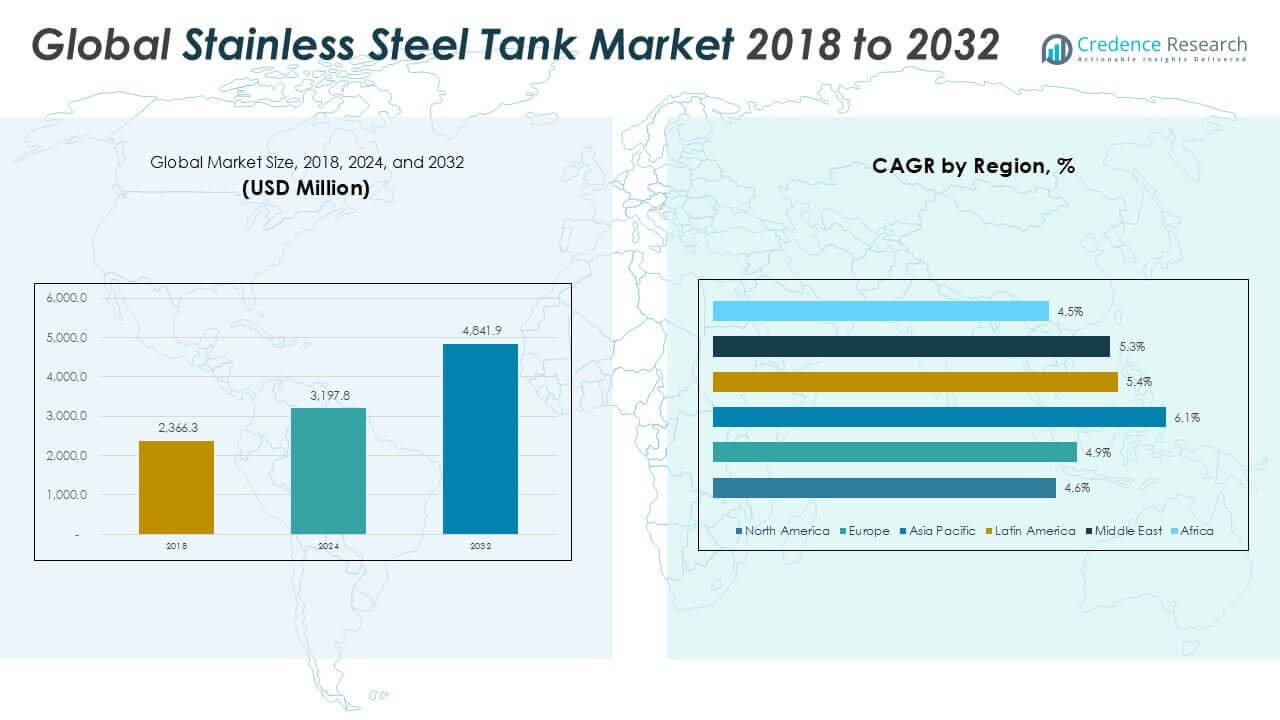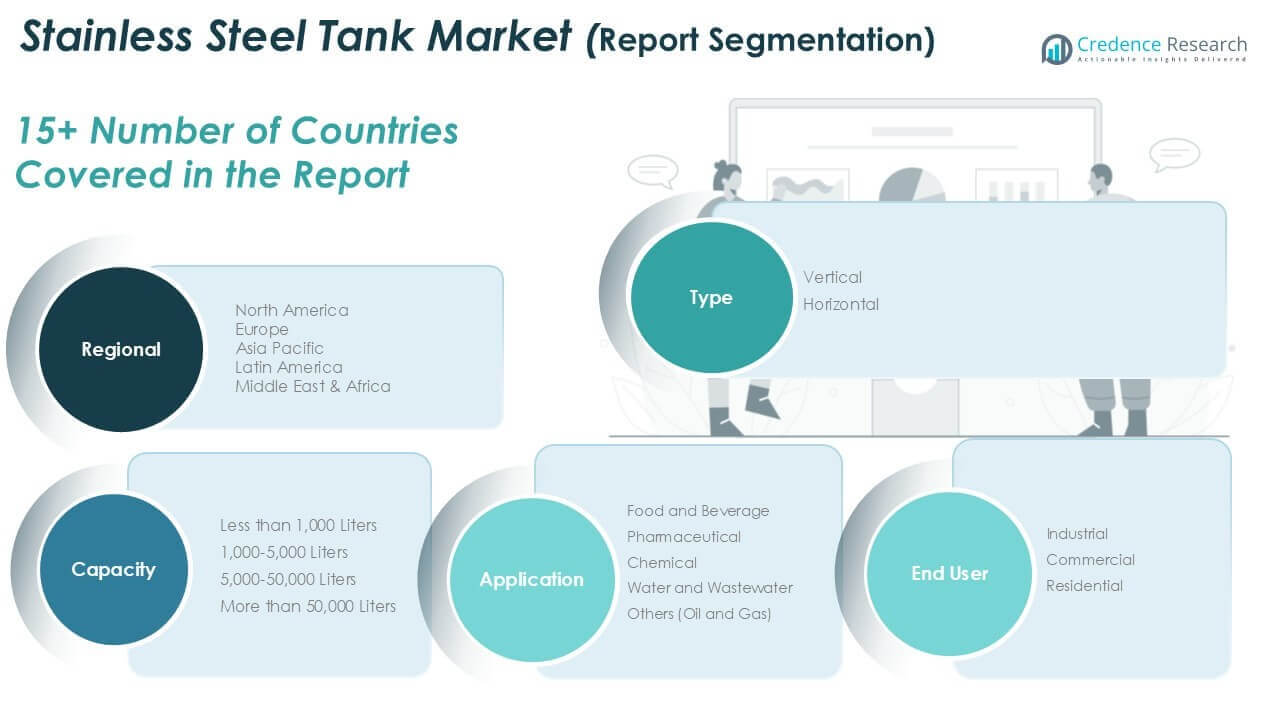CHAPTER NO. 1 : GENESIS OF THE MARKET
1.1 Market Prelude – Introduction & Scope
1.2 The Big Picture – Objectives & Vision
1.3 Strategic Edge – Unique Value Proposition
1.4 Stakeholder Compass – Key Beneficiaries
CHAPTER NO. 2 : EXECUTIVE LENS
2.1 Pulse of the Industry – Market Snapshot
2.2 Growth Arc – Revenue Projections (USD Million)
2.3. Premium Insights – Based on Primary Interviews
CHAPTER NO. 3 : STAINLESS-STEEL TANK MARKET FORCES & INDUSTRY PULSE
3.1 Foundations of Change – Market Overview
3.2 Catalysts of Expansion – Key Market Drivers
3.2.1 Momentum Boosters – Growth Triggers
3.2.2 Innovation Fuel – Disruptive Technologies
3.3 Headwinds & Crosswinds – Market Restraints
3.3.1 Regulatory Tides – Compliance Challenges
3.3.2 Economic Frictions – Inflationary Pressures
3.4 Untapped Horizons – Growth Potential & Opportunities
3.5 Strategic Navigation – Industry Frameworks
3.5.1 Market Equilibrium – Porter’s Five Forces
3.5.2 Ecosystem Dynamics – Value Chain Analysis
3.5.3 Macro Forces – PESTEL Breakdown
3.6 Price Trend Analysis
3.6.1 Regional Price Trend
3.6.2 Price Trend By Type
CHAPTER NO. 4 : KEY INVESTMENT EPICENTER
4.1 Regional Goldmines – High-Growth Geographies
4.2 Product Frontiers – Lucrative Type Categories
4.3 End User Sweet Spots – Emerging Demand Segments
CHAPTER NO. 5: REVENUE TRAJECTORY & WEALTH MAPPING
5.1 Momentum Metrics – Forecast & Growth Curves
5.2 Regional Revenue Footprint – Market Share Insights
5.3 Segmental Wealth Flow – Type, Capacity, Application, & End User Industry Revenue
CHAPTER NO. 6 : TRADE & COMMERCE ANALYSIS
6.1. Import Analysis By Region
6.1.1. Global Stainless-steel Tank Market Import Revenue By Region
6.2. Export Analysis By Region
6.2.1. Global Stainless-steel Tank Market Export Revenue By Region
CHAPTER NO. 7 : COMPETITION ANALYSIS
7.1. Company Market Share Analysis
7.1.1. Global Stainless-steel Tank Market: Company Market Share
7.2. Global Stainless-steel Tank Market Company Revenue Market Share
7.3. Strategic Developments
7.3.1. Acquisitions & Mergers
7.3.2. New Type Launch
7.3.3. Regional Expansion
7.4. Competitive Dashboard
7.5. Company Assessment Metrics, 2024
CHAPTER NO. 8 : STAINLESS-STEEL TANK MARKET – BY TYPE SEGMENT ANALYSIS
8.1. Stainless-steel Tank Market Overview By Type Segment
8.1.1. Stainless-steel Tank Market Revenue Share By Type
8.2. Vertical
8.3. Horizontal
CHAPTER NO. 9 : STAINLESS-STEEL TANK MARKET – BY CAPACITY SEGMENT ANALYSIS
9.1. Stainless-steel Tank Market Overview By Capacity Segment
9.1.1. Stainless-steel Tank Market Revenue Share By Capacity
9.2. Less than 1,000 Liters
9.3. 1,000-5,000 Liters
9.4. 5,000-50,000 Liters
9.5. More than 50,000 Liters
CHAPTER NO. 10 : STAINLESS-STEEL TANK MARKET – BY APPLICATION SEGMENT ANALYSIS
10.1. Stainless-steel Tank Market Overview By Application Segment
10.1.1. Stainless-steel Tank Market Revenue Share By Application
10.2. Food and Beverage
10.3. Pharmaceutical
10.4. Chemical
10.5. Water and Wastewater
10.6. Others
CHAPTER NO. 11 : STAINLESS-STEEL TANK MARKET – BY END USER INDUSTRY SEGMENT ANALYSIS
11.1. Stainless-steel Tank Market Overview By End User Industry Segment
11.1.1. Stainless-steel Tank Market Revenue Share By End User Industry
11.2. Residential
11.3. Commercial
11.4. Industrial
CHAPTER NO. 12 : STAINLESS-STEEL TANK MARKET – REGIONAL ANALYSIS
12.1. Stainless-steel Tank Market Overview By Region Segment
12.1.1. Global Stainless-steel Tank Market Revenue Share By Region
12.1.2. Regions
12.1.3. Global Stainless-steel Tank Market Revenue By Region
12.1.4. Type
12.1.5. Global Stainless-steel Tank Market Revenue By Type
12.1.6. Capacity
12.1.7. Global Stainless-steel Tank Market Revenue By Capacity
12.1.8. Application
12.1.9. Global Stainless-steel Tank Market Revenue By Application
12.1.10. End User Industry
12.1.11. Global Stainless-steel Tank Market Revenue By End User Industry
CHAPTER NO. 13 : NORTH AMERICA STAINLESS-STEEL TANK MARKET – COUNTRY ANALYSIS
13.1. North America Stainless-steel Tank Market Overview By Country Segment
13.1.1. North America Stainless-steel Tank Market Revenue Share By Region
13.2. North America
13.2.1. North America Stainless-steel Tank Market Revenue By Country
13.2.2. Type
13.2.3. North America Stainless-steel Tank Market Revenue By Type
13.2.4. Capacity
13.2.5. North America Stainless-steel Tank Market Revenue By Capacity
13.2.6. Application
13.2.7. North America Stainless-steel Tank Market Revenue By Application
13.2.8. End User Industry
13.2.9. North America Stainless-steel Tank Market Revenue By End User Industry
13.3. U.S.
13.4. Canada
13.5. Mexico
CHAPTER NO. 14 : EUROPE STAINLESS-STEEL TANK MARKET – COUNTRY ANALYSIS
14.1. Europe Stainless-steel Tank Market Overview By Country Segment
14.1.1. Europe Stainless-steel Tank Market Revenue Share By Region
14.2. Europe
14.2.1. Europe Stainless-steel Tank Market Revenue By Country
14.2.2. Type
14.2.3. Europe Stainless-steel Tank Market Revenue By Type
14.2.4. Capacity
14.2.5. Europe Stainless-steel Tank Market Revenue By Capacity
14.2.6. Application
14.2.7. Europe Stainless-steel Tank Market Revenue By Application
14.2.8. End User Industry
14.2.9. Europe Stainless-steel Tank Market Revenue By End User Industry
14.3. UK
14.4. France
14.5. Germany
14.6. Italy
14.7. Spain
14.8. Russia
14.9. Rest of Europe
CHAPTER NO. 15 : ASIA PACIFIC STAINLESS-STEEL TANK MARKET – COUNTRY ANALYSIS
15.1. Asia Pacific Stainless-steel Tank Market Overview By Country Segment
15.1.1. Asia Pacific Stainless-steel Tank Market Revenue Share By Region
15.2. Asia Pacific
15.2.1. Asia Pacific Stainless-steel Tank Market Revenue By Country
15.2.2. Type
15.2.3. Asia Pacific Stainless-steel Tank Market Revenue By Type
15.2.4. Capacity
15.2.5. Asia Pacific Stainless-steel Tank Market Revenue By Capacity
15.2.6. Application
15.2.7. Asia Pacific Stainless-steel Tank Market Revenue By Application
15.2.8. End User Industry
15.2.9. Asia Pacific Stainless-steel Tank Market Revenue By End User Industry
15.3. China
15.4. Japan
15.5. South Korea
15.6. India
15.7. Australia
15.8. Southeast Asia
15.9. Rest of Asia Pacific
CHAPTER NO. 16 : LATIN AMERICA STAINLESS-STEEL TANK MARKET – COUNTRY ANALYSIS
16.1. Latin America Stainless-steel Tank Market Overview By Country Segment
16.1.1. Latin America Stainless-steel Tank Market Revenue Share By Region
16.2. Latin America
16.2.1. Latin America Stainless-steel Tank Market Revenue By Country
16.2.2. Type
16.2.3. Latin America Stainless-steel Tank Market Revenue By Type
16.2.4. Capacity
16.2.5. Latin America Stainless-steel Tank Market Revenue By Capacity
16.2.6. Application
16.2.7. Latin America Stainless-steel Tank Market Revenue By Application
16.2.8. End User Industry
16.2.9. Latin America Stainless-steel Tank Market Revenue By End User Industry
16.3. Brazil
16.4. Argentina
16.5. Rest of Latin America
CHAPTER NO. 17 : MIDDLE EAST STAINLESS-STEEL TANK MARKET – COUNTRY ANALYSIS
17.1. Middle East Stainless-steel Tank Market Overview By Country Segment
17.1.1. Middle East Stainless-steel Tank Market Revenue Share By Region
17.2. Middle East
17.2.1. Middle East Stainless-steel Tank Market Revenue By Country
17.2.2. Type
17.2.3. Middle East Stainless-steel Tank Market Revenue By Type
17.2.4. Capacity
17.2.5. Middle East Stainless-steel Tank Market Revenue By Capacity
17.2.6. Application
17.2.7. Middle East Stainless-steel Tank Market Revenue By Application
17.2.8. End User Industry
17.2.9. Middle East Stainless-steel Tank Market Revenue By End User Industry
17.3. GCC Countries
17.4. Israel
17.5. Turkey
17.6. Rest of Middle East
CHAPTER NO. 18 : AFRICA STAINLESS-STEEL TANK MARKET – COUNTRY ANALYSIS
18.1. Africa Stainless-steel Tank Market Overview By Country Segment
18.1.1. Africa Stainless-steel Tank Market Revenue Share By Region
18.2. Africa
18.2.1. Africa Stainless-steel Tank Market Revenue By Country
18.2.2. Type
18.2.3. Africa Stainless-steel Tank Market Revenue By Type
18.2.4. Capacity
18.2.5. Africa Stainless-steel Tank Market Revenue By Capacity
18.2.6. Application
18.2.7. Africa Stainless-steel Tank Market Revenue By Application
18.2.8. End User Industry
18.2.9. Africa Stainless-steel Tank Market Revenue By End User Industry
18.3. South Africa
18.4. Egypt
18.5. Rest of Africa
CHAPTER NO. 19 : COMPANY PROFILES
19.1. Paul Mueller Company
19.1.1. Company Overview
19.1.2. Product Portfolio
19.1.3. Financial Overview
19.1.4. Recent Developments
19.1.5. Growth Strategy
19.1.6. SWOT Analysis
19.2. Caldwell Tanks
19.3. Highland Tank & Manufacturing Company
19.4. MEKRO Sp. z o.o.
19.5. CST Industries, Inc.
19.6. Permastore Limited
19.7. Tank Connection
19.8. Superior Tank Co., Inc.
19.9. Schumann Tank
19.10. Wheeler Tank Manufacturing, Inc.
19.11. Hanson Tank
19.12. Pfaudler, Inc.
19.13. Rexarc International, Inc.
19.14. Buckeye Fabricating Company
19.15. Bendel Tank & Heat Exchanger
19.16. Kennedy Tank & Manufacturing Co., Inc.
19.17. Southern Tank & Manufacturing, Inc.
19.18. Custom Metalcraft, Inc.
19.19. Precision Tank, Inc.
19.20. Highland Equipment Inc.









